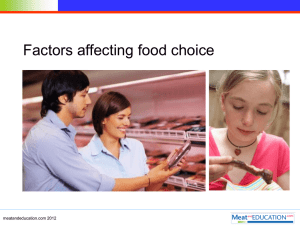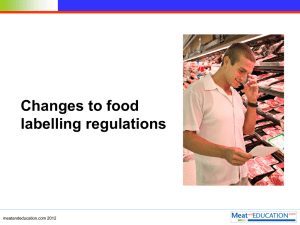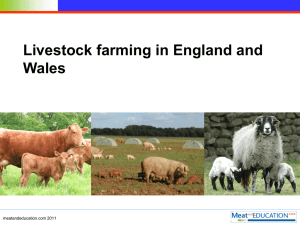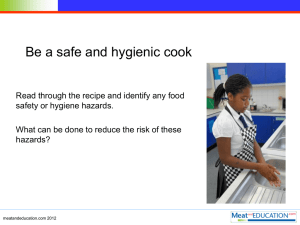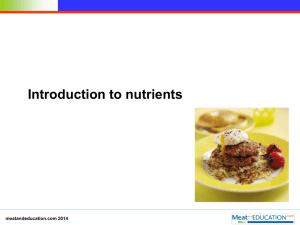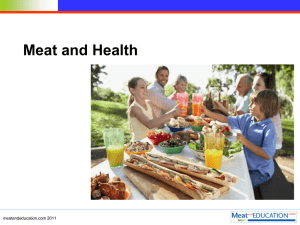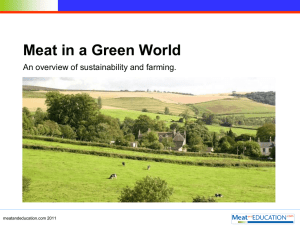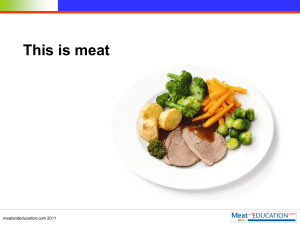Where does red meat come from.
advertisement
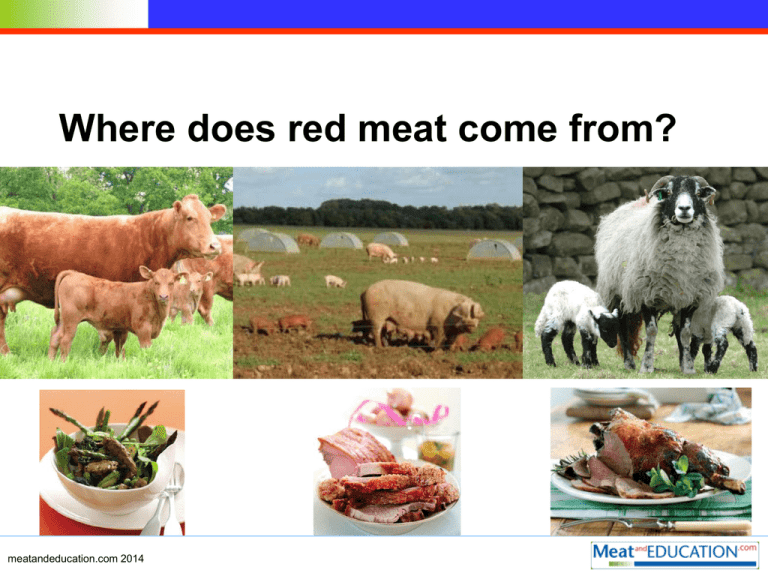
Where does red meat come from? meatandeducation.com 2014 Module focus Livestock farming for meat production has been an established industry in England, Wales and Northern Ireland for centuries. Animal health and welfare, and sustainability are high priorities for farmers. Animals have been bred to produce leaner meat which has a positive impact on our diet and health. This module contains an overview of information on how cattle, pigs and sheep are farmed. meatandeducation.com 2014 Lifecycle of the animals Pregnancy Birth 9 months 5 months Weaning 6-9 months 18-24 months 12-14 weeks 14 weeks – 1 year 4 weeks 6-7 months 3 months, 3 weeks & 3 days meatandeducation.com 2014 Finishing Health and welfare Farmers spend a lot of time with the livestock monitoring their health and welfare. Veterinarians and animal nutritionists will often work with farmers to provide expert advice on improving and maintaining animal health. Key to livestock production are five freedoms : 1. Freedom from Hunger and Thirst – by ready access to fresh water and a diet to maintain full health and vigour. 2. Freedom from Discomfort – by providing an appropriate environment including shelter and a comfortable resting area. 3. Freedom from Pain, Injury or Disease – by prevention or rapid diagnosis and treatment. 4. Freedom to Express Normal Behaviour - by providing sufficient space, proper facilities and company of the animal’s own kind. 5. Freedom from Fear and Distress – by ensuring conditions and treatment which avoid mental suffering. meatandeducation.com 2014 The environment Farmers will also maintain fences, farming equipment and other areas of the farm. Another priority for farmers is managing and maintaining the hedgerows and field boundaries, which are also wildlife habitat. Existing wetlands are preserved and managed for wildlife. Not only are trees and shrubs attractive landscape features but they are important habitats for the diversity of wildlife. Grazing cattle and sheep play an important part in managing our natural grasslands. meatandeducation.com 2014 Housing Most cattle and sheep spend the summer months in fields grazing on pasture and many are housed in large barns in the winter when the grass has stopped growing and the weather can turn bad. Pigs can be indoors or out-door reared. Housing for livestock must meet specific regulations allowing good ventilation, animals the freedom to move and socialise and access to food and water. meatandeducation.com 2014 Traceability There are national records and systems in place to ensure animals can be traced back to the farms they were born on. For example, cattle receive a passport and an ear tag which records where the animal was born. This passport travels with it and aids traceability within the industry. Sheep are tagged with ear tags when they are young and cannot be moved from the farm without a movement licence. Pigs will either be tagged or tattooed with an individual number to track their origins. meatandeducation.com 2014 Slaughtering Cattle, pigs and sheep are slaughtered in modern abattoirs where the conditions are strictly supervised and every effort is made to ensure that the operation is humane. This includes rendering the animal unconscious immediately prior to slaughter The animal carcase is initially divided into large ‘primal quarters’. These are then butchered into the various cuts, like roasting joints and steaks and offal, such as liver and kidneys. meatandeducation.com 2014 Food assurance schemes • Food assurance schemes certify the production of food products to a quality management system based on certain criteria, including food safety principles. • Red tractor, Protected Geographical Indication and Farm Quality Assurance are Food assurance schemes which cover red meat produced in England, Wales and Northern Ireland. meatandeducation.com 2014 Why choose the Red Tractor? The Red Tractor label is used as a mark of assurance and quality. Assurance - rigorous standards apply throughout the supply chain, for example animal farms and feed, livestock transportation, the slaughtering process and the production methods for processed meats. Welfare - over 100 standards relating to animal husbandry and welfare (at all stages) , design of animal housing, staff training, health monitoring, feed, animal transportation and overall animal management. meatandeducation.com 2014 Why choose the Red Tractor? Traceability - Every aspect of the red meat production process is fully traceable. Peace of mind - farms, transportation companies, abattoirs and processing plants are inspected by independent auditors at least twice a year. Red Tractor farms are inspected four times a year by specialist animal vets as well as annual spot checks by independent auditors. Farms will lose certification if they do not meet the standards. Country of origin - The flag in the Red Tractor logo guarantees that the meat has been reared on UK farms – not just processed in the UK. meatandeducation.com 2014 Farm quality assurance Northern Irish consumers are guaranteed the quality of the beef and lamb products which they are buying. This assurance scheme has very similar values to the Red Tractor scheme. Northern Irish red meat produced under the Farm Quality assurance can bear the Red Tractor logo when being sold in England. meatandeducation.com 2014 Protected Geographical Indication (PGI) The PGI status prevents unfair competition and the misleading of consumers by non-genuine products which may be of inferior quality or different flavour. PGI status was awarded by the European Commission to Welsh Beef in 2002 and to Welsh Lamb in 2003. meatandeducation.com 2014 Protected Geographical Indication (PGI) The objectives of PGI: • protect the reputation of the regional food product • promote rural and agricultural activity • help producers to obtain a premium price for their authentic products in return for a “genuine effort to improve quality” • communicate clear messages to consumers about product origin. The PGI status of Welsh Lamb and Welsh Beef guarantees the authenticity and integrity of the brand. The benefits of the natural landscape are maximised with tried and tested traditional farming techniques to produce lamb and beef to a high standard. meatandeducation.com 2014 Summary •The different animals have different lifecycles, however the health and welfare of the animals is a priority for livestock farmers. •Livestock may graze outdoors in summer, however many animals are housed in large barns during the winter to protect them from bad weather. •Livestock housing must meet certain criteria, for example stocking density, have good ventilation and allow the animals to move and be sociable. •Farmers also ensure that maintaining the environment is also a priority. •A variety of food assurance schemes operate setting out strict guidelines for farming and reassures consumers about standards of production, welfare and origin. meatandeducation.com 2014 For further information and support, go to: www.meatandeducation.com meatandeducation.com 2014
